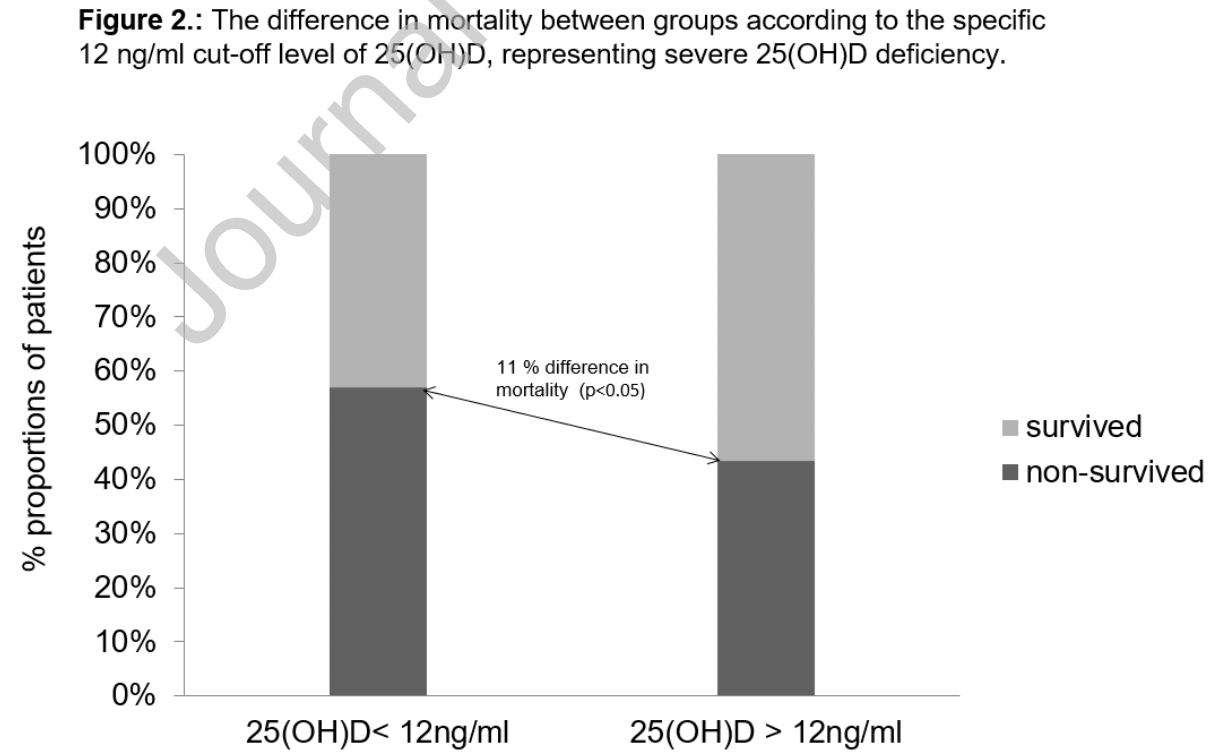Patients with COVID-19 pneumonia with 25(OH)D levels lower than 12 ng/ml are at increased risk of death
Juraj Smaha, Martin Kužma, Kristína Brázdilová, Samuel Nachtmann, Martin Jankovský, Katarína Pastírová, Andrea Gažová, Peter Jackuliak, Zdenko Killinger, Ján Kyselovič, Tomáš Koller, Neil Binkley, Juraj Payer
International Journal of Infectious Diseases, doi:10.1016/j.ijid.2022.01.044
This is a PDF file of an article that has undergone enhancements after acceptance, such as the addition of a cover page and metadata, and formatting for readability, but it is not yet the definitive version of record. This version will undergo additional copyediting, typesetting and review before it is published in its final form, but we are providing this version to give early visibility of the article. Please note that, during the production process, errors may be discovered which could affect the content, and all legal disclaimers that apply to the journal pertain.
assessment at admission could be relevant for the risk stratification and planning for treatment strategy in patients with COVID-19.
Conflict of Interest The authors declare that they have no known competing financial interests or personal relationships that could have appeared to influence the work reported in this paper.
Ethical Approval Statement The study was conducted in accordance with the Declaration of Helsinki and was approved by The Ethics Committee of the University Hospital Bratislava. An informed and written consent was obtained either from the participants or a first degree relative.
References
Amrein, Scherkl, Hoffmann, Neuwersch-Sommeregger, Köstenberger et al., Vitamin D deficiency 2.0: an update on the current status worldwide, Eur J Clin Nutr,
doi:10.1038/s41430-020-0558-yBeyerstedt, Casaro, Rangel, COVID-19: angiotensin-converting enzyme 2 (ACE2) expression and tissue susceptibility to SARS-CoV-2 infection, Eur J Clin Microbiol Infect Dis,
doi:10.1007/s10096-020-04138-6Bishop, Ismailova, Dimeloe, Hewison, White, Vitamin D and immune regulation: antibacterial, antiviral, anti-inflammatory, JBMR Plus,
doi:10.1002/jbm4.10405Chen, Mei, Xie, Yuan, Ma et al., Low vitamin D levels do not aggravate COVID-19 risk or death, and vitamin D supplementation does not improve outcomes in hospitalized patients with COVID-19: a meta-analysis GRADE assessment of cohort studies and RCTs, Nutr J,
doi:10.1186/s12937-021-00744-yGetachew, Tizabi, Vitamin D and COVID-19: Role of ACE2, age, gender, and ethnicity, J Med Virol,
doi:10.1002/jmv.27075Giustina, Adler, Binkley, Bollerslev, Bouillon et al., Consensus statement from 2 nd International Conference on Controversies in Vitamin D, Rev Endocr Metab Disord,
doi:10.1007/s11154-019-09532-wGrant, Lahore, Mcdonnell, Baggerly, French et al., Evidence that Vitamin D Supplementation Could Reduce Risk of Influenza and COVID-19 Infections and Deaths, Nutrients,
doi:10.3390/nu12040988Hetta, Muhammad, El-Masry, Taha, Ahmed et al., The interplay between vitamin D and COVID-19: protective or bystander?, Eur Rev Med Pharmacol Sci,
doi:10.26355/eurrev_202102_25119Hussain, Jabeen, Raza, Shabbir, Baig et al., Structural variations in human ACE2 may influence its binding with SARS-CoV-2 spike protein, J Med Virol,
doi:10.1002/jmv.25832Lips, Cashman, Lamberg-Allardt, Bischoff-Ferrari, Obermayer-Pietsch et al., Current vitamin D status in European and Middle East countries and strategies to prevent vitamin D deficiency: a position statement of the European Calcified Tissue Society, Eur J Endocrinol,
doi:10.1530/EJE-18-0736Martineau, Jolliffe, Hooper, Greenberg, Aloia et al., Vitamin D supplementation to prevent acute respiratory tract infections: systematic review and meta-analysis of individual participant data, BMJ,
doi:10.1136/bmj.i6583Mascolo, Scavone, Rafaniello, Angelis, Urbanek et al., The Role of Renin-Angiotensin-Aldosterone System in the Heart and Lung: Focus on COVID-19, Front Pharmacol,
doi:10.3389/fphar.2021.667254Merad, Martin, Pathological inflammation in patients with COVID-19: a key role for monocytes and macrophages, Nat Rev Immunol,
doi:10.1038/s41577-020-0331-4Murai, Fernandes, Sales, Pinto, Goessler et al., Effect of a Single High Dose of Vitamin D3 on Hospital Length of Stay in Patients With
{ 'indexed': {'date-parts': [[2022, 1, 22]], 'date-time': '2022-01-22T16:41:23Z', 'timestamp': 1642869683316},
'reference-count': 0,
'publisher': 'Elsevier BV',
'license': [ { 'start': { 'date-parts': [[2022, 1, 1]],
'date-time': '2022-01-01T00:00:00Z',
'timestamp': 1640995200000},
'content-version': 'tdm',
'delay-in-days': 0,
'URL': 'https://www.elsevier.com/tdm/userlicense/1.0/'},
{ 'start': { 'date-parts': [[2022, 1, 19]],
'date-time': '2022-01-19T00:00:00Z',
'timestamp': 1642550400000},
'content-version': 'vor',
'delay-in-days': 18,
'URL': 'http://creativecommons.org/licenses/by-nc-nd/4.0/'}],
'content-domain': {'domain': [], 'crossmark-restriction': False},
'short-container-title': ['International Journal of Infectious Diseases'],
'published-print': {'date-parts': [[2022, 1]]},
'DOI': '10.1016/j.ijid.2022.01.044',
'type': 'journal-article',
'created': {'date-parts': [[2022, 1, 22]], 'date-time': '2022-01-22T16:13:23Z', 'timestamp': 1642868003000},
'source': 'Crossref',
'is-referenced-by-count': 0,
'title': [ 'COVID-19 pneumonia patients with 25(OH)D levels lower than 12 ng/ml are at increased risk of '
'death'],
'prefix': '10.1016',
'author': [ {'given': 'Smaha', 'family': 'Juraj', 'sequence': 'first', 'affiliation': []},
{'given': 'Kužma', 'family': 'Martin', 'sequence': 'additional', 'affiliation': []},
{'given': 'Brázdilová', 'family': 'Kristína', 'sequence': 'additional', 'affiliation': []},
{'given': 'Nachtmann', 'family': 'Samuel', 'sequence': 'additional', 'affiliation': []},
{'given': 'Jankovský', 'family': 'Martin', 'sequence': 'additional', 'affiliation': []},
{'given': 'Pastírov á', 'family': 'Katarína', 'sequence': 'additional', 'affiliation': []},
{'given': 'Gažová', 'family': 'Andrea', 'sequence': 'additional', 'affiliation': []},
{'given': 'Jackuliak', 'family': 'Peter', 'sequence': 'additional', 'affiliation': []},
{'given': 'Killinger', 'family': 'Zdenko', 'sequence': 'additional', 'affiliation': []},
{'given': 'Kyselovič', 'family': 'Ján', 'sequence': 'additional', 'affiliation': []},
{'given': 'Koller', 'family': 'Tomáš', 'sequence': 'additional', 'affiliation': []},
{'given': 'Binkley', 'family': 'Neil', 'sequence': 'additional', 'affiliation': []},
{'given': 'Payer', 'family': 'Juraj', 'sequence': 'additional', 'affiliation': []}],
'member': '78',
'container-title': ['International Journal of Infectious Diseases'],
'original-title': [],
'language': 'en',
'link': [ { 'URL': 'https://api.elsevier.com/content/article/PII:S1201971222000522?httpAccept=text/xml',
'content-type': 'text/xml',
'content-version': 'vor',
'intended-application': 'text-mining'},
{ 'URL': 'https://api.elsevier.com/content/article/PII:S1201971222000522?httpAccept=text/plain',
'content-type': 'text/plain',
'content-version': 'vor',
'intended-application': 'text-mining'}],
'deposited': { 'date-parts': [[2022, 1, 22]],
'date-time': '2022-01-22T16:13:24Z',
'timestamp': 1642868004000},
'score': 1,
'subtitle': [],
'short-title': [],
'issued': {'date-parts': [[2022, 1]]},
'references-count': 0,
'alternative-id': ['S1201971222000522'],
'URL': 'http://dx.doi.org/10.1016/j.ijid.2022.01.044',
'relation': {},
'ISSN': ['1201-9712'],
'issn-type': [{'value': '1201-9712', 'type': 'print'}],
'subject': ['Infectious Diseases', 'Microbiology (medical)', 'General Medicine'],
'published': {'date-parts': [[2022, 1]]}}
